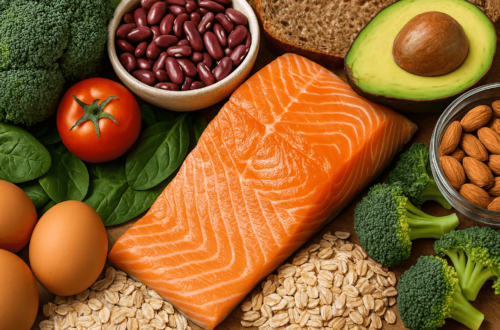
Why Diet Matters for Diabetics Over 50: How the Right Nutrition Can Help Control Blood Sugar
As we age, our bodies go through various changes, including changes in metabolism, hormone levels, and the way we process food. These changes can be especially noticeable for people over the age of 50, particularly those living with diabetes. Managing diabetes effectively after the age of 50 requires more than just medication—diet plays a critical role in controlling blood sugar levels and preventing complications. In this article, we’ll explore the importance of managing diabetes after 50, how the right nutrition can help improve blood sugar levels and the need for tailored nutrition as we age.
The Importance of Managing Diabetes After 50
Diabetes, particularly Type 2 diabetes, is a condition that becomes more prevalent with age. In fact, the risk of developing Type 2 diabetes increases significantly after the age of 50 due to factors such as reduced physical activity, changes in hormone levels, and insulin resistance. Proper management of diabetes after 50 is crucial because poorly controlled blood sugar can lead to a range of complications, including:
- Heart disease: Diabetics have an increased risk of cardiovascular problems such as heart attacks, strokes, and high blood pressure.
- Kidney damage: Long-term uncontrolled diabetes can damage the kidneys, potentially leading to kidney failure.
- Vision problems: Diabetic retinopathy is a common cause of blindness in older adults.
- Neuropathy: Uncontrolled blood sugar can cause nerve damage, leading to numbness, tingling, and pain in the hands and feet.
The key to preventing these complications is consistent and effective blood sugar management, and diet is a fundamental component of that control.
How the Right Nutrition Can Help Improve Blood Sugar Levels
Managing blood sugar levels through diet is one of the most effective ways to manage diabetes, especially after the age of 50. As we age, the body’s ability to use insulin efficiently decreases, making blood sugar regulation more challenging. However, by focusing on a balanced diet, you can help stabilize your blood sugar and reduce the need for medication. Here are several key ways the right nutrition can help:
1. Control Carbohydrates
Carbohydrates directly impact blood sugar levels, making it important for diabetics to monitor their intake. Foods that are high in refined sugars and starches can cause spikes in blood sugar, while complex carbohydrates—like whole grains, legumes, and vegetables—provide a steady release of energy without causing sudden fluctuations. The key is not to eliminate carbs entirely, but rather to choose the right type and manage portion sizes.
Incorporating fiber-rich foods, such as vegetables, beans, and whole grains, can slow the absorption of sugar and prevent spikes in blood sugar. Fiber also aids digestion and supports healthy gut bacteria, which has a positive impact on insulin sensitivity.
2. Prioritize Lean Proteins
Lean proteins, such as chicken, fish, tofu, and beans, should be the cornerstone of a diabetic-friendly diet. Protein helps stabilize blood sugar levels by slowing the absorption of glucose. It also supports muscle maintenance, which is important for metabolic health, especially as we age. Including adequate protein in each meal helps maintain steady blood sugar levels and keeps hunger at bay, preventing overeating and unhealthy snacking.
3. Healthy Fats for Better Insulin Sensitivity
Healthy fats, like those found in avocado, olive oil, and nuts, can help improve insulin sensitivity and reduce inflammation. Unlike saturated fats, which are found in processed foods and can worsen insulin resistance, healthy fats promote better metabolic function and overall health. Consuming moderate amounts of healthy fats in meals can also help you feel fuller for longer and avoid blood sugar spikes between meals.
4. Focus on Low-Glycemic Foods
The glycemic index (GI) is a measure of how quickly foods increase blood sugar levels. Foods with a high GI, such as white bread, pasta, and sugary snacks, cause rapid spikes in blood sugar. In contrast, low-GI foods, such as non-starchy vegetables, legumes, and whole grains, release glucose more slowly and help keep blood sugar levels steady. Including more low-GI foods in your diet is essential for blood sugar control.
5. Tailored Nutrition as We Age
As we get older, our nutritional needs change. People over 50 require more nutrients such as calcium, vitamin D, and B12, and their metabolism may slow down, making weight management more difficult. Additionally, seniors may experience changes in taste and appetite, making healthy eating more challenging. For people with diabetes, it’s especially important to focus on nutrient-dense foods that provide essential vitamins and minerals while keeping blood sugar in check.
Incorporating foods that are rich in antioxidants, such as berries, leafy greens, and colorful vegetables, can help fight the oxidative stress that often accompanies diabetes and aging. These foods can help protect the body from inflammation, support heart health, and promote better circulation—all essential for diabetics over 50.
The Need for Tailored Nutrition for Diabetics Over 50
The dietary needs of people with diabetes change over time. After the age of 50, the body’s ability to process glucose and regulate insulin naturally declines, making it even more important to follow a nutrition plan that is tailored to the individual’s specific health needs. While general diabetes advice applies to all age groups, seniors over 50 need a plan that takes into account the following:
- Slower metabolism: As metabolism slows with age, it becomes easier to gain weight, which can worsen diabetes symptoms. A well-balanced, lower-calorie diet can help maintain a healthy weight and prevent complications.
- Increased risk of other health issues: Seniors often face other chronic health issues like heart disease, hypertension, and osteoporosis. A diet rich in heart-healthy fats, fiber, and anti-inflammatory foods can address multiple health concerns simultaneously.
- Maintaining muscle mass: Sarcopenia, or the loss of muscle mass, is common as we age. Protein intake is essential for maintaining muscle mass and ensuring the body can use insulin effectively.
Introducing the “Diabetic Diet After 50”
Managing diabetes through diet doesn’t have to be complicated or time-consuming, especially if you have a clear plan. That’s where “The Diabetic Diet After 50” comes in. This cookbook is designed specifically for individuals over 50 who are looking to manage their diabetes through easy-to-follow, nutritious meals.
In “The Diabetic Diet After 50”, you’ll find:
Diabetic-friendly recipes that focus on low-glycemic foods, lean proteins, and healthy fats.
Meal planning tips that help you make nutritious choices without feeling overwhelmed.
Nutritional information for every recipe, so you can keep track of calories, carbs, and key nutrients that support blood sugar control.
Easy-to-make meals that can be prepared quickly, even for those with a busy lifestyle or limited cooking time.
This cookbook takes the guesswork out of diabetic meal planning, offering a practical guide to healthy eating that’s tailored to the needs of seniors. Whether you’re newly diagnosed or looking for fresh meal ideas to help manage your blood sugar, “The Diabetic Diet After 50” is the perfect tool to help you eat well and live well.
Proper nutrition plays an essential role in managing diabetes, especially for those over 50. By making conscious, informed decisions about what to eat, you can control your blood sugar, prevent complications, and improve your quality of life. “The Diabetic Diet After 50” is more than just a cookbook—it’s a guide to making diabetes-friendly meals that fit your lifestyle. With easy recipes, nutritional information, and meal planning tips, this book is an invaluable resource for anyone looking to manage their diabetes and live their best life after 50.
Ready to take control of your health with delicious, nutritious meals? Grab your copy of “The Diabetic Diet After 50” today!



